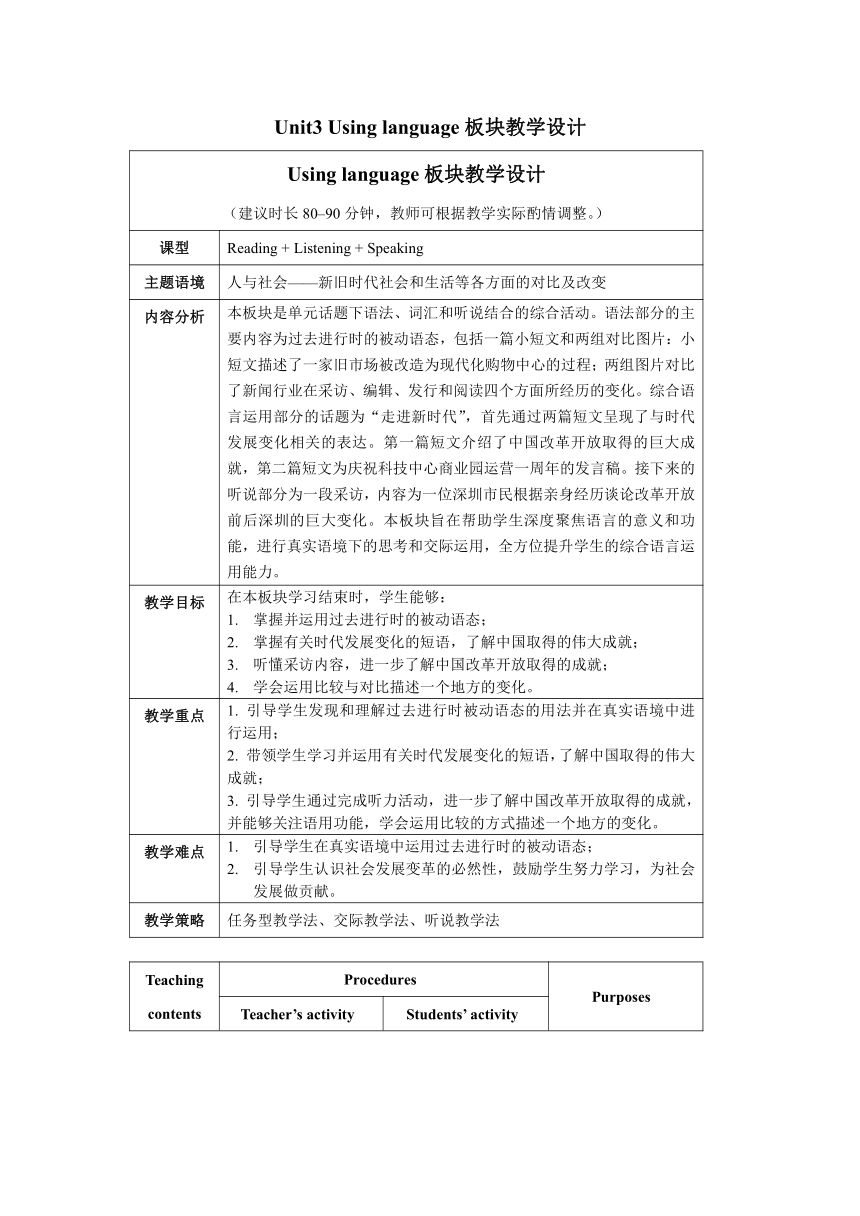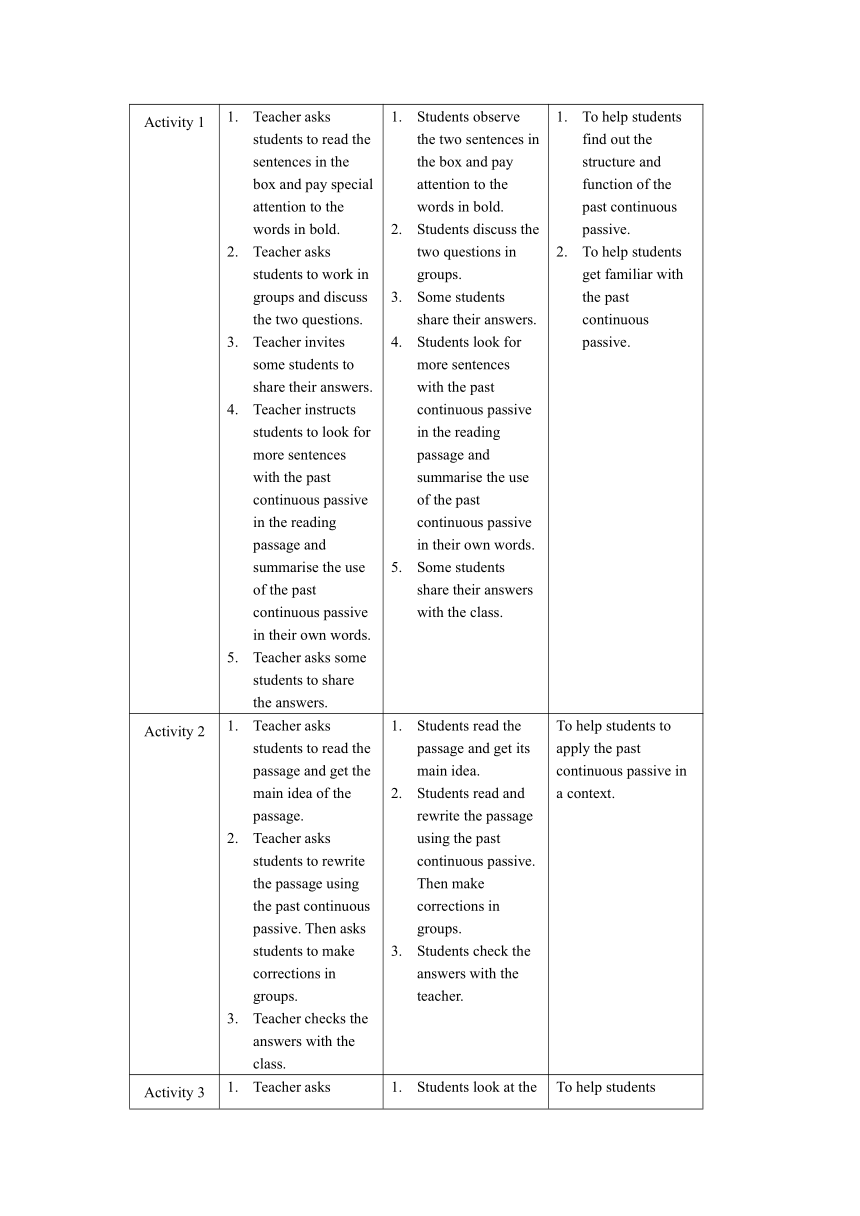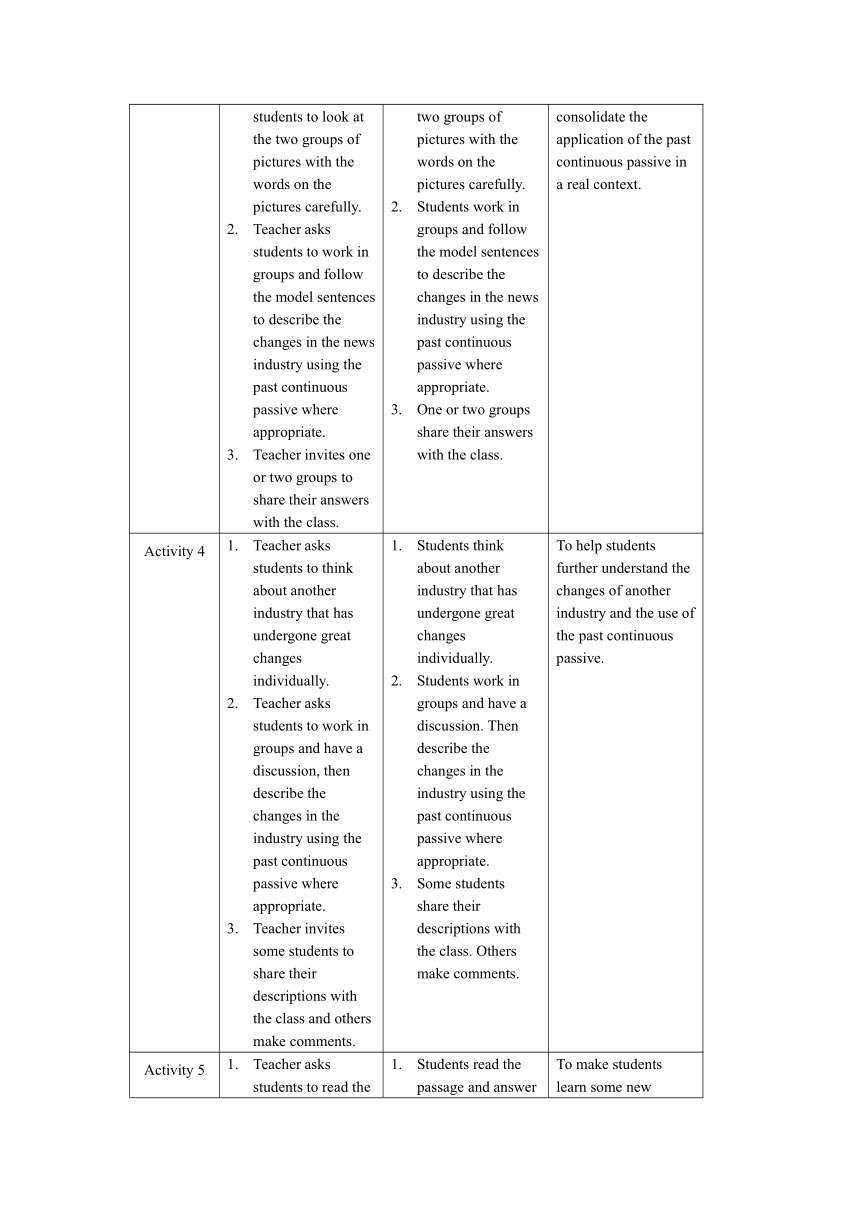外研版(2019)选择性必修第二册 Unit3 Times change! Using language板块教学设计
文档属性
| 名称 | 外研版(2019)选择性必修第二册 Unit3 Times change! Using language板块教学设计 |

|
|
| 格式 | docx | ||
| 文件大小 | 25.2KB | ||
| 资源类型 | 教案 | ||
| 版本资源 | 外研版(2019) | ||
| 科目 | 英语 | ||
| 更新时间 | 2023-03-03 16:36:48 | ||
图片预览



文档简介
Unit3 Using language板块教学设计
Using language板块教学设计 (建议时长80–90分钟,教师可根据教学实际酌情调整。)
课型 Reading + Listening + Speaking
主题语境 人与社会——新旧时代社会和生活等各方面的对比及改变
内容分析 本板块是单元话题下语法、词汇和听说结合的综合活动。语法部分的主要内容为过去进行时的被动语态,包括一篇小短文和两组对比图片:小短文描述了一家旧市场被改造为现代化购物中心的过程;两组图片对比了新闻行业在采访、编辑、发行和阅读四个方面所经历的变化。综合语言运用部分的话题为“走进新时代”,首先通过两篇短文呈现了与时代发展变化相关的表达。第一篇短文介绍了中国改革开放取得的巨大成就,第二篇短文为庆祝科技中心商业园运营一周年的发言稿。接下来的听说部分为一段采访,内容为一位深圳市民根据亲身经历谈论改革开放前后深圳的巨大变化。本板块旨在帮助学生深度聚焦语言的意义和功能,进行真实语境下的思考和交际运用,全方位提升学生的综合语言运用能力。
教学目标 在本板块学习结束时,学生能够: 掌握并运用过去进行时的被动语态; 掌握有关时代发展变化的短语,了解中国取得的伟大成就; 听懂采访内容,进一步了解中国改革开放取得的成就; 学会运用比较与对比描述一个地方的变化。
教学重点 1. 引导学生发现和理解过去进行时被动语态的用法并在真实语境中进行运用; 2. 带领学生学习并运用有关时代发展变化的短语,了解中国取得的伟大成就; 3. 引导学生通过完成听力活动,进一步了解中国改革开放取得的成就,并能够关注语用功能,学会运用比较的方式描述一个地方的变化。
教学难点 引导学生在真实语境中运用过去进行时的被动语态; 引导学生认识社会发展变革的必然性,鼓励学生努力学习,为社会发展做贡献。
教学策略 任务型教学法、交际教学法、听说教学法
Teaching contents Procedures Purposes
Teacher’s activity Students’ activity
Activity 1 Teacher asks students to read the sentences in the box and pay special attention to the words in bold. Teacher asks students to work in groups and discuss the two questions. Teacher invites some students to share their answers. Teacher instructs students to look for more sentences with the past continuous passive in the reading passage and summarise the use of the past continuous passive in their own words. Teacher asks some students to share the answers. Students observe the two sentences in the box and pay attention to the words in bold. Students discuss the two questions in groups. Some students share their answers. Students look for more sentences with the past continuous passive in the reading passage and summarise the use of the past continuous passive in their own words. Some students share their answers with the class. To help students find out the structure and function of the past continuous passive. To help students get familiar with the past continuous passive.
Activity 2 Teacher asks students to read the passage and get the main idea of the passage. Teacher asks students to rewrite the passage using the past continuous passive. Then asks students to make corrections in groups. Teacher checks the answers with the class. Students read the passage and get its main idea. Students read and rewrite the passage using the past continuous passive. Then make corrections in groups. Students check the answers with the teacher. To help students to apply the past continuous passive in a context.
Activity 3 Teacher asks students to look at the two groups of pictures with the words on the pictures carefully. Teacher asks students to work in groups and follow the model sentences to describe the changes in the news industry using the past continuous passive where appropriate. Teacher invites one or two groups to share their answers with the class. Students look at the two groups of pictures with the words on the pictures carefully. Students work in groups and follow the model sentences to describe the changes in the news industry using the past continuous passive where appropriate. One or two groups share their answers with the class. To help students consolidate the application of the past continuous passive in a real context.
Activity 4 Teacher asks students to think about another industry that has undergone great changes individually. Teacher asks students to work in groups and have a discussion, then describe the changes in the industry using the past continuous passive where appropriate. Teacher invites some students to share their descriptions with the class and others make comments. Students think about another industry that has undergone great changes individually. Students work in groups and have a discussion. Then describe the changes in the industry using the past continuous passive where appropriate. Some students share their descriptions with the class. Others make comments. To help students further understand the changes of another industry and the use of the past continuous passive.
Activity 5 Teacher asks students to read the passage and answer the first question. Teacher checks the answers with the class. Teacher asks students to pay attention to the expressions in bold and then answer the second question. Teacher invites some students to share their answers with the class. Students read the passage and answer the first question. Students check the answers with the teacher. Students pay attention to the expressions in bold and then answer the second question. Some students share their answers with the class. To make students learn some new expressions about the changes of times.
Activity 6 Teacher asks students to complete the speech with the correct form of the expressions in Activity 5. Teacher checks the answers with the class. Students complete the speech with the correct form of the expressions in Activity 5. Students check the answers with the teacher. To help students review the expressions about the changes of times.
Activity 7 Teacher asks students to read the sentences and find out the purpose of the activity. Teacher plays the audio and asks students to choose the correct answer. Teacher checks the answer with the students. Students read the sentences and find out the purpose of the activity. Students listen to the audio and choose the correct answer. Students check the answer with the teacher. To train the skills in grasping the main idea of an interview through listening.
Activity 8 Teacher asks students to look at the interview record first. Then plays the audio again and asks students to complete the interview record. Teacher asks students to listen for the third time and check the answers by themselves. Teacher invites some students to share their answers with the class. Teacher asks students to talk about the changes in Shenzhen in their own words. Students look at the interview record first. Then listen to the audio again and complete the interview record. Students listen to the audio for the third time and check the answers by themselves. Some students share their answers with the class. Students talk about the changes in Shenzhen in their own words. To help students to get the details of the listening material.
Activity 9 Teacher asks students to look at the two headers and tell what they know about the different functions. Teacher asks students to complete the boxes with the expressions from the interview. Teacher checks the answers with the class. Students look at the two headers and tell what they know about the different functions. Students complete the boxes with the expressions from the interview. Students check the answers with the teacher. To help students consolidate the expressions of describing a place and comparisons of past and now.
Activity 10 Teacher divides students into pairs and asks them to describe the changes in their home town using the expressions in this section. Teacher invites several pairs to present their ideas in front of the class. Teacher asks students to think about how well they can use the language they have learnt to express themselves. Students work in pairs and describe the changes in their home town using the expressions in this section. Several pairs present their ideas in front of the class. Students think about how well they can use the language they have learnt to express themselves. To encourage students to further practise describing changes in a place.
Using language板块教学设计 (建议时长80–90分钟,教师可根据教学实际酌情调整。)
课型 Reading + Listening + Speaking
主题语境 人与社会——新旧时代社会和生活等各方面的对比及改变
内容分析 本板块是单元话题下语法、词汇和听说结合的综合活动。语法部分的主要内容为过去进行时的被动语态,包括一篇小短文和两组对比图片:小短文描述了一家旧市场被改造为现代化购物中心的过程;两组图片对比了新闻行业在采访、编辑、发行和阅读四个方面所经历的变化。综合语言运用部分的话题为“走进新时代”,首先通过两篇短文呈现了与时代发展变化相关的表达。第一篇短文介绍了中国改革开放取得的巨大成就,第二篇短文为庆祝科技中心商业园运营一周年的发言稿。接下来的听说部分为一段采访,内容为一位深圳市民根据亲身经历谈论改革开放前后深圳的巨大变化。本板块旨在帮助学生深度聚焦语言的意义和功能,进行真实语境下的思考和交际运用,全方位提升学生的综合语言运用能力。
教学目标 在本板块学习结束时,学生能够: 掌握并运用过去进行时的被动语态; 掌握有关时代发展变化的短语,了解中国取得的伟大成就; 听懂采访内容,进一步了解中国改革开放取得的成就; 学会运用比较与对比描述一个地方的变化。
教学重点 1. 引导学生发现和理解过去进行时被动语态的用法并在真实语境中进行运用; 2. 带领学生学习并运用有关时代发展变化的短语,了解中国取得的伟大成就; 3. 引导学生通过完成听力活动,进一步了解中国改革开放取得的成就,并能够关注语用功能,学会运用比较的方式描述一个地方的变化。
教学难点 引导学生在真实语境中运用过去进行时的被动语态; 引导学生认识社会发展变革的必然性,鼓励学生努力学习,为社会发展做贡献。
教学策略 任务型教学法、交际教学法、听说教学法
Teaching contents Procedures Purposes
Teacher’s activity Students’ activity
Activity 1 Teacher asks students to read the sentences in the box and pay special attention to the words in bold. Teacher asks students to work in groups and discuss the two questions. Teacher invites some students to share their answers. Teacher instructs students to look for more sentences with the past continuous passive in the reading passage and summarise the use of the past continuous passive in their own words. Teacher asks some students to share the answers. Students observe the two sentences in the box and pay attention to the words in bold. Students discuss the two questions in groups. Some students share their answers. Students look for more sentences with the past continuous passive in the reading passage and summarise the use of the past continuous passive in their own words. Some students share their answers with the class. To help students find out the structure and function of the past continuous passive. To help students get familiar with the past continuous passive.
Activity 2 Teacher asks students to read the passage and get the main idea of the passage. Teacher asks students to rewrite the passage using the past continuous passive. Then asks students to make corrections in groups. Teacher checks the answers with the class. Students read the passage and get its main idea. Students read and rewrite the passage using the past continuous passive. Then make corrections in groups. Students check the answers with the teacher. To help students to apply the past continuous passive in a context.
Activity 3 Teacher asks students to look at the two groups of pictures with the words on the pictures carefully. Teacher asks students to work in groups and follow the model sentences to describe the changes in the news industry using the past continuous passive where appropriate. Teacher invites one or two groups to share their answers with the class. Students look at the two groups of pictures with the words on the pictures carefully. Students work in groups and follow the model sentences to describe the changes in the news industry using the past continuous passive where appropriate. One or two groups share their answers with the class. To help students consolidate the application of the past continuous passive in a real context.
Activity 4 Teacher asks students to think about another industry that has undergone great changes individually. Teacher asks students to work in groups and have a discussion, then describe the changes in the industry using the past continuous passive where appropriate. Teacher invites some students to share their descriptions with the class and others make comments. Students think about another industry that has undergone great changes individually. Students work in groups and have a discussion. Then describe the changes in the industry using the past continuous passive where appropriate. Some students share their descriptions with the class. Others make comments. To help students further understand the changes of another industry and the use of the past continuous passive.
Activity 5 Teacher asks students to read the passage and answer the first question. Teacher checks the answers with the class. Teacher asks students to pay attention to the expressions in bold and then answer the second question. Teacher invites some students to share their answers with the class. Students read the passage and answer the first question. Students check the answers with the teacher. Students pay attention to the expressions in bold and then answer the second question. Some students share their answers with the class. To make students learn some new expressions about the changes of times.
Activity 6 Teacher asks students to complete the speech with the correct form of the expressions in Activity 5. Teacher checks the answers with the class. Students complete the speech with the correct form of the expressions in Activity 5. Students check the answers with the teacher. To help students review the expressions about the changes of times.
Activity 7 Teacher asks students to read the sentences and find out the purpose of the activity. Teacher plays the audio and asks students to choose the correct answer. Teacher checks the answer with the students. Students read the sentences and find out the purpose of the activity. Students listen to the audio and choose the correct answer. Students check the answer with the teacher. To train the skills in grasping the main idea of an interview through listening.
Activity 8 Teacher asks students to look at the interview record first. Then plays the audio again and asks students to complete the interview record. Teacher asks students to listen for the third time and check the answers by themselves. Teacher invites some students to share their answers with the class. Teacher asks students to talk about the changes in Shenzhen in their own words. Students look at the interview record first. Then listen to the audio again and complete the interview record. Students listen to the audio for the third time and check the answers by themselves. Some students share their answers with the class. Students talk about the changes in Shenzhen in their own words. To help students to get the details of the listening material.
Activity 9 Teacher asks students to look at the two headers and tell what they know about the different functions. Teacher asks students to complete the boxes with the expressions from the interview. Teacher checks the answers with the class. Students look at the two headers and tell what they know about the different functions. Students complete the boxes with the expressions from the interview. Students check the answers with the teacher. To help students consolidate the expressions of describing a place and comparisons of past and now.
Activity 10 Teacher divides students into pairs and asks them to describe the changes in their home town using the expressions in this section. Teacher invites several pairs to present their ideas in front of the class. Teacher asks students to think about how well they can use the language they have learnt to express themselves. Students work in pairs and describe the changes in their home town using the expressions in this section. Several pairs present their ideas in front of the class. Students think about how well they can use the language they have learnt to express themselves. To encourage students to further practise describing changes in a place.
